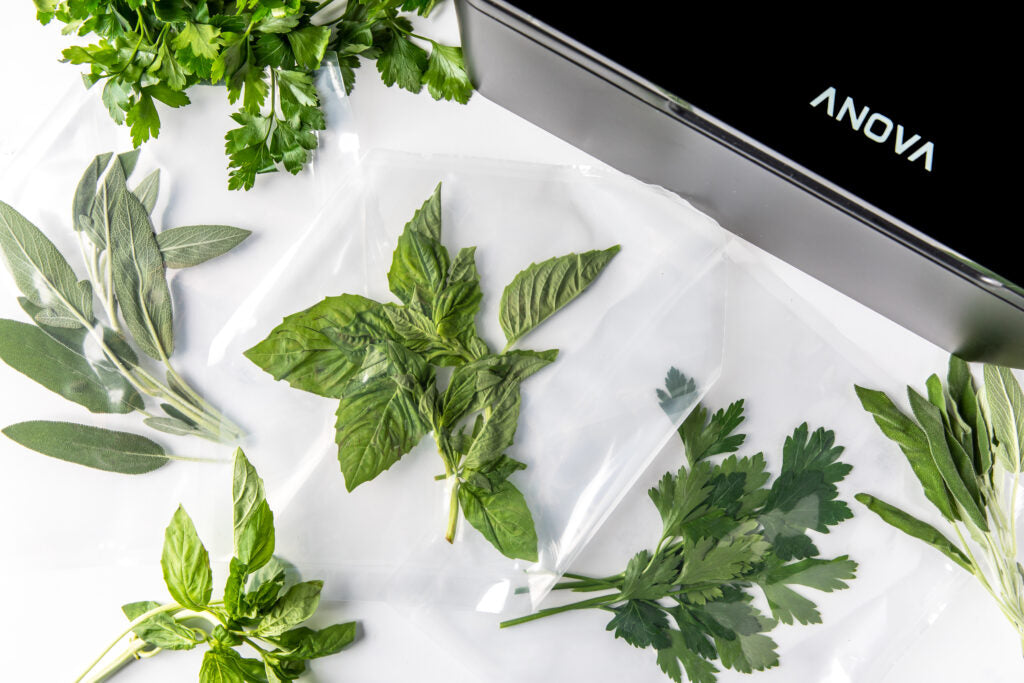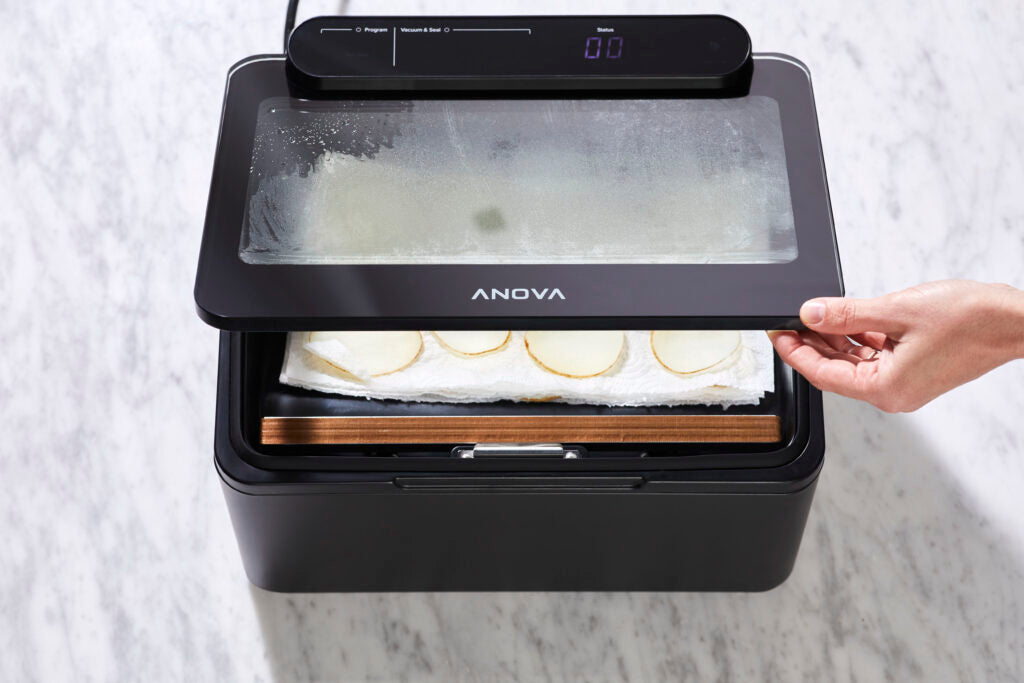You may have seen chamber vacuums (or CVacs, for short) in restaurant kitchens. They are typically used for creating airtight seals on food items that may need to be stored or cooked sous vide, as well as for special techniques like compression and infusion. In this blog post, I’ll be breaking down some of the science of chamber vacuum sealers so you can decide if this is an appliance that would be useful for your own kitchen, professional or otherwise.
For me, CVacs have always been one of those specialty appliances, alongside PacoJets and blast chillers, that make fine-dining cooking so difficult to replicate at home. At one fancy kitchen, we would use a CVac to compress persimmons in a light syrup until glossy and mosaic-like. At another, we used it to vacuum seal big bags of chicken bones with water and aromatics to be cooked sous vide — an excellent way to ensure proper stock consistency. During a stint interning at a seafood distribution facility, we used CVacs to seal small jars of ultra-luxe caviar so they would stay fresh longer. My favorite application, though, was probably watching pastry chefs aerate chocolate in them. What a delight to see those big bubbles captured in chilled chocolate form!
Now that CVacs like the Anova Precision Chamber Vacuum Sealer are more widely available, I'm excited that I can finally bring these processes into my home kitchen.

How a Chamber Vacuum Sealer Works
A CVac is a special appliance that is able to securely seal ingredients in a container (such as a plastic pouch) by evacuating all of the air inside its chamber through the use of a powerful vacuum. Once the air pressure is equalized both inside and outside of the container, the CVac then creates an airtight seal to enclose the ingredients inside the container. This sounds quite abstract, so the easiest way to understand chamber vacuum sealers is by comparing them to a standard suction edge sealer, such as the Anova Precision Vacuum Sealer.
How a Suction Edge Sealer Works
A suction edge sealer functions by slowly extracting all the air from inside a bag, then creating an airtight seal by heating up an area of the plastic bag so it melts and seals completely.
However, due to the way suction edge sealers operate, they struggle to seal ingredients that contain liquid; it also is caught in the extraction process, and attempts to seal often result in liquid spilling everywhere across the sealer. (Now just imagine me trying to outwit an edge sealer while attempting to seal giant bag of whole milk to make ricotta.) This hassle extends to items that are not liquid, but moist, such as fresh cheeses, fish, or meat — as the moisture tends to get caught in the suction.
Another drawback to an edge sealer is that it usually does not remove all of the air out of a pouch before sealing it; its sensors tend to have issues with picking up small air pockets lodged between sticky food items, like these fermented short ribs. Not only does this residual air allow for the sealed items to decay faster than those not exposed to any extra oxygen, it also creates problems with sealed bags stubbornly floating during the sous vide process (and thus cooking unevenly). 
The Chamber Vacuum Sealing Process
Compared to an edge sealer, a CVac is more adept at sealing liquid, delicate, and oddly shaped items. Instead of suctioning air from a bag that is outside of the vacuum sealer, CVacs have a chamber in which you place the pouch of ingredients. After the lid of the CVac is closed, the vacuum cycle begins:
- The vacuum pump removes oxygen from the chamber, including what is inside the pouch. As a result, the pressure in the chamber is lower than the outside of the chamber. At this stage, you may see your pouch puff up because air is leaving the chamber more quickly than from inside the pouch (i.e. the pressure in the pouch is higher than the rest of the chamber for a short period of time).
- The amount of pressure, measured in millibars (or mbars) used in this process varies. For context, at 50 mbars, 95% of the air is removed, whereas at 5 mbars 99.5% of the air is removed. In the Anova Precision Chamber Vacuum Sealer, the mbars range from 150 down to 50 mbars.
- Once all of the oxygen is removed from the chamber and the pouch, the sealing bar on the CVac heats up a line on the pouch and creates an airtight seal.
- The CVac allows the pressure inside the chamber to equalize with the pressure outside. As the pouch is already sealed, it cannot acclimate to the same pressure alongside the rest of the chamber. Thus, the pressure inside the chamber returning to normal atmospheric conditions causes the pouch to collapse or be “vacuumed.”
- For ingredients that may be more delicate, some chamber vacuum sealers come with adjustable levels of pressure so you’re able to apply a gentler pressure for certain foods. In other cases, you can adjust down the time of the vacuum cycle.
- In some CVac models, there is also a “gas flush cycle” that helps prevent the pressure from collapsing on top of the ingredients in the pouch.
This process results in a very tight package that contains no air inside, which is ideal for long-term food storage and long sous vide cooks. Notably, this also prevents the terrible taste of freezer burn from happening to foods you love!
Use Cases For A Chamber Vacuum
In addition to sealing and storage uses, I’ve been using my CVac for certain cooking techniques, such as infusions, compressions, and rapid cooling. It’s quite satisfying to finally be able to recreate some of the things from professional kitchens that I wanted to make at home for friends and family to sample, like small cubes of compressed watermelon masquerading as tuna, or rapid-infused roasted garlic oil.
All three of these applications are pre-programmed into the Anova Precision Chamber Vacuum with automatic pressures and times already set to make things extra easy.

Infusions & Extractions
A CVac speeds up the process for extracting flavor from ingredients and infusing into into a base liquid. For example, vanilla extract (vanilla infused into neutral alcohol) and rosemary olive oil (rosemary infused into olive oil).
When the CVac vacuum pump removes air from the chamber, the pressure will also pop the pockets of air and water inside the ingredient and liquid base. When the vacuum is released and the pressure is allowed to equalize, all the flavor molecules of the ingredient being extracted from will then rush in and fill the opened pockets in the liquid base. (It’s normal to see some bubbling in the liquid during this step.) No seal is necessary to do these infusions, and you can repeat the vacuum cycle many times to extract and infuse as much flavor as possible.
For infusions specifically, I sometimes also use jars (with the lid off) that fit within the chamber instead of pouches.
Recipe Ideas:
- Infused oils (e.g., a neutral canola oil infused with roasted chiles and garlic)
- Flavored extracts (e.g., homemade vanilla extract with used vanilla bean husk and vodka)
- Flavored vinegars (e.g., bubbly and tropical pineapple vinegar made from pineapple pulp and rice vinegar)
- Infused alcohol (e.g., homemade limoncello or even kumquat-cello)

Compressions
This is essentially the same process as infusions, but with compressions the focus is on moving flavor compounds in a liquid into the air pockets within solid ingredients. The best ingredients I have found for compressions are fruits and vegetables that are already quite porous, like watermelon and cucumber, as they have lots of air and water pockets that can be re-filled with the liquid’s flavor. In a compression, you’ll be using a much lower volume of liquid than an infusion, but this liquid should be much more flavorful and concentrated.
In addition to speeding up a process that would otherwise take much longer, compressions under pressure alter the final texture of the solid ingredient that can’t be done with other methods. This is because as the pressure inside the chamber falls to a certain degree, the vaporized moisture ruptures the cell walls of the ingredient. Once these cell walls have collapsed, light will pass through the food instead of being scattered and diffused. This process changes an opaque food to one with a noticeable and lovely translucency. Lower pressures and longer vacuum cycles will achieve this effect the most efficiently.
A Note on Meat Marinades...
It is worth noting that while a CVac is very useful for the storage of meats in liquid marinades, ensuring that there’s even distribution and no leaking with an airtight seal, it does not speed up the marination process. The structure inside of meat and other proteins is not fragile enough to collapse under the vacuum pressure.
Recipe Ideas:
- Compressed fruits (e.g., sake compressed lychee)
- Quick pickles (e.g., a rapid version of Chinese cucumber pickles)
- Cured meats (e.g., my beet-cured salmon)
- Candied fruits (e.g., just-sweetened Meyer lemons)
- Quick hydrations (e.g., pasta dough and cookie dough but without the rest time!)
Unlike infusions, compressions should be done in a flexible pouch. This is because air should not be let back into the compressed ingredient after the vacuum cycle finishes so it is exchanged with the liquid flavorings instead. With a flexible pouch, the weight of the pressure refilling the chamber will tamp down on the ingredient and create the desired effect.

Dry/Cool
Also called flash cooling, this often-overlooked setting on the CVac comes in handy when you’re looking to bring down the temperature of cooked foods very quickly. I've found it especially effective for porous foods with a substantial amount of moisture inside, such as bread. The underlying principle at work here is evaporative cooling, where, as the pressure inside the chamber decreases, so does the boiling point of water, and the water inside the ingredient begins to evaporate, thus both cooling the ingredient and drying it at the same time.
In this program, the vacuum cycle also allows a bit of fresh air to pass into the chamber as to avoid too many air and moisture pockets rupturing (ultimately resulting in a too-dry end product).
Recipe Ideas:
- Fast gnocchi (e.g., cut your gnocchi-making time in half by using the CVac to dehydrate and cool cooked potato. I've made a special gnocchi recipe in honor of this CVac!)
- Quick bread pudding (e.g., use the CVac to rapidly cool and dehydrate cooked bread, so that it can absorb more rum ;) )
The CVac has always been the one of those kitchen supplies I would’ve considered striking up a bargain with a restaurant friend to use. It’s pretty exciting to these techniques are finally available more readily to the public, so I hope this blog has been helpful for those who have decided to opt into a CVac. Happy cooking!
Related Posts:
How to use steam in the Anova Precision OvenWater Physics 101
Secrets to Sous Vide Seasoning

